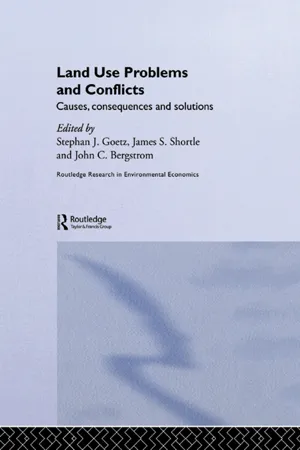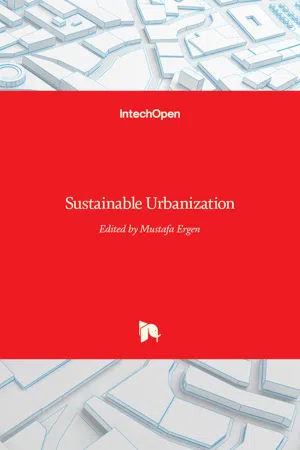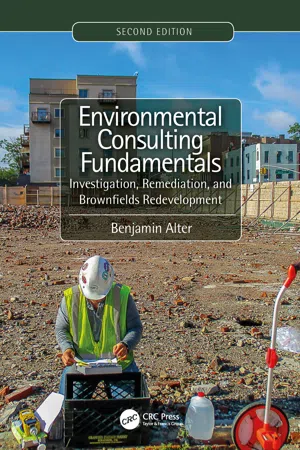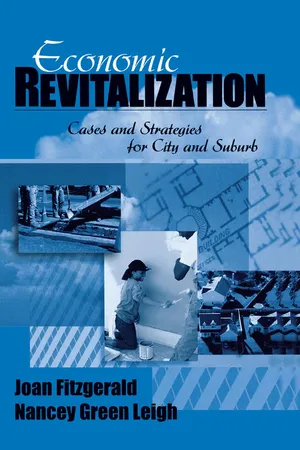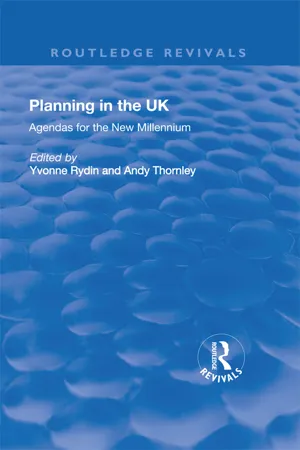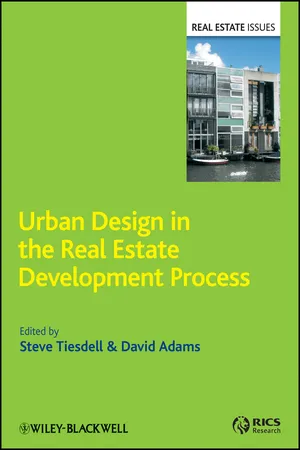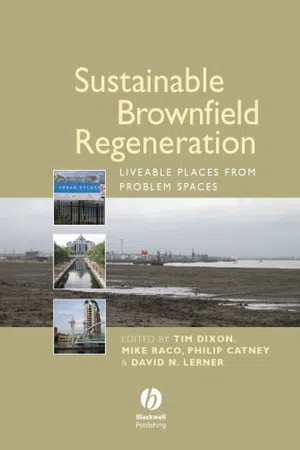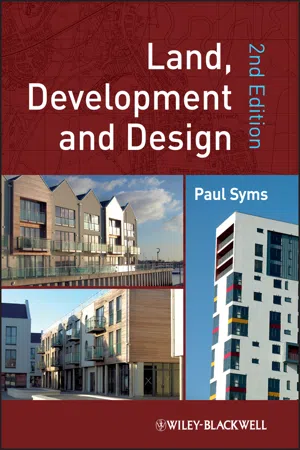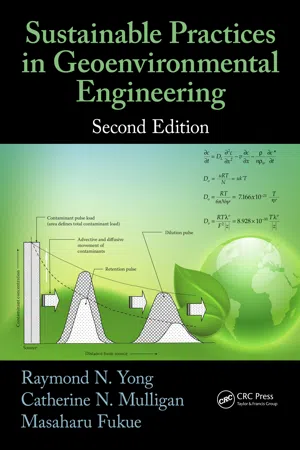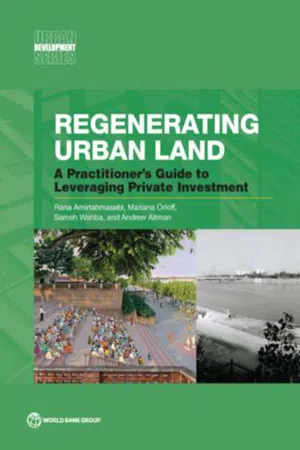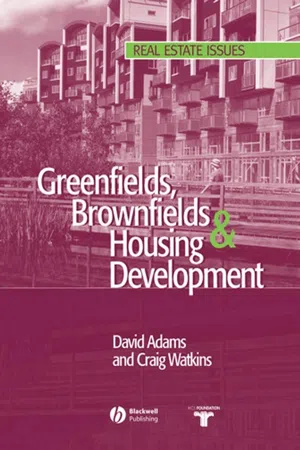Geography
Brownfield Redevelopment
Brownfield redevelopment refers to the process of revitalizing and reusing abandoned or underutilized industrial or commercial sites, often contaminated by hazardous substances. This redevelopment aims to promote sustainable land use, economic growth, and community revitalization. It involves remediation of environmental hazards, infrastructure improvements, and repurposing the site for residential, commercial, or recreational purposes.
Written by Perlego with AI-assistance
Related key terms
1 of 5
11 Key excerpts on "Brownfield Redevelopment"
- eBook - ePub
Land Use Problems and Conflicts
Causes, Consequences and Solutions
- John C. Bergstrom, Stephen J Goetz, James S. Shortle(Authors)
- 2004(Publication Date)
- Routledge(Publisher)
In these two cases, as well as in others, sprawl has been the impetus for forest fragmentation and parcelization. While the environmental and public health implications of these land use changes are profound, so are the community-level impacts. Hither-to-fore rural communities are rapidly changing into full-fledged suburbs and the local economic bases of these communities are changing from being resource-based into ones that reflect a transformation into bedroom communities where only the service sector is growing. Good jobs with benefits are being lost and are replaced by lower paying ones, often without an accompanying portfolio of benefits. And the social capital existing in the community is also eroding as the separation between work and residence becomes that much greater.Brownfields redevelopmentThe redevelopment of abandoned, contaminated and vacant properties is one of the mainstays of contemporary urban planning and policy, as Nancey Green Leigh has noted in a thoughtful paper. Of the various approaches to redevelopment none are as ubiquitous, so she has observed, as programs to clean up and restore brownfields. As she writes: “adopted by 48 states, brownfield voluntary cleanup programs are perhaps the most widespread of these approaches. While these programs vary in their overall effectiveness, they can be a successful tool for encouraging the redevelopment of contaminated sites” (Leigh 2003: 7). Some of the most aggressive programs of this type are found in Pennsylvania, Michigan, Massachusetts and especially in New Jersey. All such programs aim to direct development onto brown-fields and away from greenfields, thus helping to promote a smart growth agenda.Unlike vacant fields, brownfields are harmed lands and, by definition, “land and structures that are known to be contaminated or perceived to be contaminated that are underutilized or not used” (Greenberg et al. 2001a: 130). Remnants of America’s great industrial and manufacturing age, there are literally hundreds of thousands of brownfield sites across the country. Most such sites are located in urban areas, especially the industrial zones and districts of older cities. However, they are also found in the mature suburbs surrounding these cities and even in small towns across the American landscape (Greenberg et al - eBook - PDF
- Mustafa Ergen(Author)
- 2016(Publication Date)
- IntechOpen(Publisher)
However, brownfields are generally not economically competitive when compared with greenfields without any public intervention. There are economic, social, and environmental barriers in returning the brownfields to beneficial uses. In spite of all problems, these sites may include, they are also regarded as an opportunity in providing sustainable urban development and to bring extra values into poor‐quality lands and declined urban parts. Sustainability has become a major issue in development strategies since the end of 1980s. As it is well known, in Brutland Report sustainable development is defined as “development that meets the needs of the present without compromising the ability of future generations to meet their own needs” [2]. At this point, it is necessary to think about whether all the brownfields regeneration projects really obtain sustainable development in the cities. What are the driving forces, policies, and handicaps in returning these areas into beneficial uses? Such a thought impulse us to ask what are the essential strategies in sustainable brownfield regeneration? Before determining the sustainable brownfield regeneration, it may be useful to look at the definitions about brownfields in all around the world. 2. Brownfield definitions In the beginning of brownfield‐related researches, one important problem is the lack of a common definition accepted by all countries in the world. The term “brownfield site” has different meanings in different countries. According to USEPA's renewed official definition brownfield site is “real property, the expansion, redevelopment, or reuse of which may be complicated by the presence or potential presence of a hazardous substance, pollutant, or contaminant”. 1 Unlike the EPA's definition, brownfields are more referred to “previously developed lands” than “contaminated sites” in UK and are accepted as all abounded, idled, 1 Small Business Liability Relief and Brownfields Revitalization Act, 2002. - eBook - ePub
Environmental Consulting Fundamentals
Investigation, Remediation, and Brownfields Redevelopment, Second Edition
- Benjamin Alter(Author)
- 2019(Publication Date)
- CRC Press(Publisher)
As with the earlier chapters on investigation and remediation, brownfields typically are real estate, that is, properties that can be bought or sold. The appearance in the definition of brownfields of terms such as “expansion,” “redevelopment,” and “reuse” identifies them by their economic rather than their technical or scientific condition. The definition implicitly states that brownfields are properties that currently are unused, underutilized, or not being used to their best economic advantage. As such, they are contributors to urban blight and its associated sociological problems.11.2.2 Practical Definition of a BrownfieldFor practical purposes, brownfields can be separated into two categories. The first category includes properties for which property expansion redevelopment (which will be called “redevelopment” for the rest of this chapter) likely is economically viable. Typical economic evaluations of such a property are shown in Tables 11.1 and 11.2 . The complications in redeveloping the property consist of uncertainties in timing, budget, liability relating to the presence or potential presence of contamination.The second category includes properties whose redevelopment is complicated because of economic considerations. Such properties, common in areas of urban blight, might be worthless or even have a negative worth (colloquially known as an “underwater” or “upside-down” property) due to environmental contamination. Consider the same property as evaluated in Table 11.1 , but, as shown in Table 11.3 - eBook - ePub
Economic Revitalization
Cases and Strategies for City and Suburb
- Joan Fitzgerald, Nancey Green Leigh(Authors)
- 2002(Publication Date)
- SAGE Publications, Inc(Publisher)
3 The Brownfield Redevelopment ChallengeIntroduction to the Brownfield ProblemBrownfields pose one of the most significant forces for unleveling the economic development playing field between, on the one hand, central cities and older suburbs and, on the other hand, young suburbs, edge cities, and the exurban fringe. Defined as previously used parcels of land where knowledge, or merely the suspicion, of contamination hinders future redevelopment potential, the label “brownfields” distinguishes such sites from never-before-developed sites, or, greenfields (U.S. Environmental Protection Agency [EPA], 1995; Bartsch, 1996; Leigh, 1996).Knowledge and suspicion of a site’s contamination typically results in its no longer being considered for redevelopment and can even taint prospects for contiguous sites. This is due to the liability that owners of a contaminated site assume by law, whether or not they were the actual contaminators, and the costs—which may not be fully calculable at the outset—incurred to clean up the site for reuse. The resulting “environmental redlining” or “brownlining” (i.e., identifying areas to be excluded from redevelopment considerations) could significantly dim the economic prospects for the population residing near the site, as well as hurt the municipality’s tax base (Leigh, 1994).Heavy industrial facilities, such as steel mills, as well as chemical and other types of processing plants, are among the best-recognized sources of environmental contamination. However, brownfields can result from ubiquitous service-oriented facilities such as gas stations, auto repair shops, and dry cleaners, which have been prime contributors to the pollution of land, water, and air. Furthermore, the U.S. Environmental Protection Agency (EPA) has estimated that one fourth of the nation’s several million underground storage tanks holding petroleum or other hazardous substances for industrial, commercial, and residential uses could be leaking, thereby contaminating the surrounding soil and ground-water. Also contributing to pervasive contamination problems is the historic practice of off-site disposal of industrial waste in landfill sites not designed to contain hazardous and toxic chemicals. - eBook - ePub
Planning in the UK
Agendas for the New Millennium
- Andy Thornley, Yvonne Rydin(Authors)
- 2018(Publication Date)
- Routledge(Publisher)
A number of governmental and academic studies undertaken in the UK and elsewhere have reflected the difficulties associated with the absence of a common definition of, and taxonomy for, brownfield sites. In discussing urban housing capacity, the Department of the Environment, Transport and the Regions observes that “Large vacant and derelict sites can be a blind spot for capacity studies” and that “several capacity studies appear to have excluded large sites by default due to the use of typical urban area techniques” (DETR, 2000: 13). Syms (1999: 3) in discussing the problems of defining brownfield and identifying the potential of previously used land for development, has noted that “Taken altogether, therefore, these problems contribute to the tortuous path of redeveloping brownfields”. Gibbons et al (1998: 152) in examining the situation in the USA observe that, among other issues, brownfield development is hindered due to “uncertainties arising from inadequate site information and competing redevelopment objectives”, whilst the establishment of the CLARINET programme by the European Union reflects the need “to develop technical recommendations for social decision making in the rehabilitation of contaminated sites” (Bardos et al, 1999: 237).Defining Brownfield
The term “brownfield” would appear to have two main derivations. The first is that it signifies the opposite of greenfield and, although there is no official recorded definition in the UK of either greenfield or brownfield (Raynsford, 1998), the use of the term greenfield is generally taken to mean land which has not previously been developed (POST, 1998). Therefore, the term brownfield has been adopted to describe land which has previously been subject to development. Development is defined in the Town and Country Planning Act 1990 as follows: “The carrying out of building, engineering, mining or other operations, in, on, over or under land, or the making of any material change in the use of any buildings or other land”.The use of the term “development” in this definition could be interpreted as a simple change of use. However, as types of development vary, and in some interpretations could include development as recreational space where no permanent buildings are erected, the use of the term brownfield is generally related to some former hard end-use that has involved physical construction, or to a situation where an industrial process, such as mineral extraction or sewage farming, takes place. - Steve Tiesdell, David Adams(Authors)
- 2011(Publication Date)
- Wiley-Blackwell(Publisher)
A number of different definitions and understandings of the term ‘brownfield’ are in existence, and these often differ from country to country or between jurisdictions. In some instances, the definitional approach finds its origins in environmental protection, whereas elsewhere the term may be used primarily in relation to land use. Having regard for the international audience for this book, it is important to define what we mean by the term ‘brownfield’ in this chapter. Syms first defined ‘brownfield’ in the UK context in a conference paper in 1993 and then in a book chapter in 1994, as ‘any areas of land which have previously been the subject of a man-made or non-agricultural use of any type. This would include industrial uses such as chemical works, heavy engineering, shipbuilding and textile processing, together with unfit housing clearance sites and docklands, both inland and coastal, as well as mineral extraction sites and those used for landfill purposes.’ (Syms, 1994: 63) As will be appreciated, this is a very broad definition, especially when viewed against a contemporary US definition: ‘brownfield: abandoned, idled or underused industrial and commercial facility where expansion or redevelopment is complicated by real or perceived environmental contamination.’ (Fields, 1995).The US definition, which is generally applied throughout North America and in a number of other countries, therefore links brownfield with specifically industrial and commercial sites, synonymous with contamination, whereas the UK approach includes housing sites and land that is lying derelict without there necessarily being any concerns regarding contamination. The UK understanding of the term brownfield is the one generally used in UK policy measures and in this chapter.- eBook - PDF
Sustainable Brownfield Regeneration
Liveable Places from Problem Spaces
- Tim Dixon, Mike Raco, Philip Catney, David N. Lerner, Tim Dixon, Mike Raco, Philip Catney, David N. Lerner(Authors)
- 2008(Publication Date)
- Wiley-Blackwell(Publisher)
This is achieved by means of creating a more spatially integrated, mixed urban environment composed of resource-efficient and high-quality buildings (DETR, 1998). Furthermore, encoura-ging greater amounts of development on previously developed land helps to reduce pressure on greenfield sites as demand for housing is projected to grow from 20.2 million in 1996 to 24 million households by 2021 (ODPM, 1999). For these reasons, the government has stipulated that a minimum of 60% of new housing has to be built on brownfield sites. 316 Sustainable Brownfield Regeneration However, the unequivocal equating of ‘brownfield’ with ‘sustainability’ is more problematic than it would at first appear. First, it is specious to assume that a redeveloped site is ‘sustainable’ simply because its old land use does not exist anymore, or that all traces of it have been removed. In addition, it asserts that the new land use must be ‘more’ sustainable than the old use, which, in the absence of methodologically sound sustainability indicators, must remain a matter of conjecture. Furthermore, Deakin and Edwards (1993) as well as Imrie and Thomas (1993) argued that few critical checks are undertaken to ensure that regeneration projects are sustainable. Housing on brownfield sites has often been of poor quality (Adams and Watkins, 2002), with buildings on brownfield regeneration projects (BRPs) having low environmental efficiency (Ball, 1999), in many cases inferior to that of much greenfield development. In addition, where redevelopment includes remediation, risks that arise from this process need to be evalu-ated, managed and placed in the context of the beneficial future land use. Decision makers hence need to understand and improve the sustainabil-ity of brownfield developments across their life cycles. However, in order for them to do this we argue that they require better sustainability mon-itoring support tools. - eBook - PDF
- Paul Syms(Author)
- 2010(Publication Date)
- Wiley-Blackwell(Publisher)
7.5 Summary Property development is not just about building new homes and places in which we can work or spend our leisure time. It is also about creating good environ- ments, in which people feel safe and happy to be there. Recent research at the University of Manchester, funded by the Homes and Communities Agency, has examined the ‘social impact’ of reusing brownfield land. One of the many findings from the research was that the redevelopment of brownfield sites had the capacity to bring about ‘extensive processes of social change’ (Schulze-Baing and Syms, 2009, p. 23), with some new development taking place in parts of cities that previ- ously had been ‘no-go ’ areas. One disappointment observed by the researchers was that in only one of the projects studied had any ‘green’ infrastructure been provided – in a development in Leeds, where allotment gardens were being pro- vided as part of the project. The case studies in this chapter have illustrated a variety of ways in which local communities, as individuals, businesses or other community-based organisations, can be actively involved in brownfield and similar regeneration projects. A diverse range of skills is required to bring such projects to fruition and, quite often, latent skills may be there in the community, unknown and unseen until a project is conceived. 7.6 Checklist • While conducting the initial site inspection and on subsequent visits, seek to ascertain whether the proposed development site is subject to any informal use by the community, whether authorised or not. Community Involvement in Tackling Blight and Dereliction 161 • Consider any issues that may be of importance to the community, such as loss of open space and increased traffic on the local road network, both during and after the development period. • Check to see whether any concerns have been raised over the condition of the site and whether any actions have been taken to remedy community concerns. - No longer available |Learn more
- Raymond N. Yong, Catherine N. Mulligan, Masaharu Fukue(Authors)
- 2014(Publication Date)
- CRC Press(Publisher)
The National Brownfield Program has resulted in the assessment of over 20,000 sites, 872 cleanups, and almost 16,200 hectares made ready for reuse (USEPA, 2014). Once a cleanup option has been chosen for a brownfield, the technology will be imple-mented and monitored to determine if cleanup levels are reached. Additional contamination Determine if site is contaminated Redevelopment is possible Site assessment and investigation Evaluation according to regulations Is cleanup of site required? End of project Are cleanup options economic and technically feasible? Was contamination removed, controlled or contained? Additional remediation procedures Yes Yes Yes Yes Yes No No No No Examine cleanup options Is redevelopment practical? Toward redevelopment Further evaluation of risks FIGURE 7.10 Evaluation of a brownfield project. (Adapted from USEPA, Road Map to Understanding Innovative Technology Options for Brownfields Investigation and Cleanup , 2nd ed., U.S. Environmental Protection Agency, Office of Solid Waste and Emergency Response, Washington, DC, EPA, 542 B-99-009, 1999b.) 244 Sustainable Practices in Geoenvironmental Engineering may be found that was not initially discovered. Long-term monitoring, particularly for natural attenuation, may be required. The site can only be developed when the regulatory levels have been achieved. The USEPA (1999a) organized various elements into a model framework (illustrated in Figure 7.11). Many of the principles of sustainability are incorporated into this process to enable the project to be sustainable for the community in the future. The framework is designed to assist municipalities, planners, and developers to undertake brownfields projects. The technologies used should incorporate resource conservation, materials reuse, public safety and mobility, and information availability. - eBook - PDF
Regenerating Urban Land
A Practitioner's Guide to Leveraging Private Investment
- Rana Amirtahmasebi, Mariana Orloff, Sameh Wahba, Andrew Altman(Authors)
- 2016(Publication Date)
- World Bank(Publisher)
Brownfield may include operational or abandoned factory sites, dumping sites, or any structures containing (or perceived to contain) substances hazardous to human health. Assets 129 4. This section is heavily based on “The Management of Brownfield Redevelopment. A Guidance Note” (World Bank 2010). For more details on Brownfield Redevelopment, see http://www-wds.worldbank .org/external/default/WDSContentServer/WDSP/IB/2010/06/14 /000333037_20100614004032/Rendered/PDF/550090WP0P118011 PUBLIC10brownfields.pdf. 5. For an overview of remediation technologies, see: The Management of Brownfields Redevelopment, Annex 5, World Bank. 6. This section is based on the World Bank Working Paper “Financing Mechanisms for Addressing Remediation of Site Contamination.” October 2014. References Ballaney, S. 2008. Town Planning Mechanism in Gujarat . Washington, DC: World Bank Institute. Ballaney, Shirley, M. Bertaud, P. Clarke Annez, C. K Koshy, B. Nair, B. Patel, V. Phatak, and V. Thawakar. 2013. Inventory of Public land in Ahmedabad, Gujarat, India. Washington, DC: World Bank. Barro, J. 2014. “Affordable Housing That’s Very Costly, The Upshot.” New York Times , June 7. http://www.nytimes.com/2014/06/08/upshot /affordable-housing-thats-very-costly.html?abt=0002&abg=0. Centre for Liveable Cities. 2014. Urban Systems Studies: Land Acquisition and Resettlement: Securing Resources for Development. Singapore: Centre for Liveable Cities. City of New York. 2015a. http://www.nyc.gov/html/dcp/html/zone/zonehis .shtml. ———. 2015b. http://www.nyc.gov/html/dcp/html/zone/glossary.shtml. City of Nis. 2012. E-Newsletter 37 (January). Cordato, R. 2001. The Polluter Pays Principle: A Proper Guide for Environmental Policy . Washington, DC: Institute for Research on the Economics of Taxation. Enemark, Stig, Keith Clifford Bell, Christiaan Lemmen, and Robin McLaren. 2014. “Fit-For-Purpose Land Administration.” FIG and World Bank, Copenhagen. - David Adams, Craig Watkins(Authors)
- 2008(Publication Date)
- Wiley-Blackwell(Publisher)
The chapter begins with a quantitative assessment of brownfield develop-ment potential. Although headline figures of recent performance may appear to provide grounds for optimism in meeting the 60% brownfield target, we argue that caution is needed in interpreting past trends. Moreover, since uncertainty surrounds estimates of future supplies at both the national and local levels, we contend that the institutional measures by which brownfield development potential can best be realised deserve as much, if not more, at-tention than the precise calculation of that potential. This leads on to the second part of the chapter, which investigates how the Brownfield Redevelopment process is impeded by specific constraints, such as planning, physical and ownership difficulties. These constraints mean that, while towns and cities can appear to the general public to contain nu-merous brownfield sites capable of residential development, the practical suitability of brownfield land for development may well be limited, unless the state acts to ensure that such supply-side constraints are overcome. Yet irrespective of any such action, housebuilders will not be persuaded to switch their activities increasingly to brownfield sites unless they perceive a demand for their products. The third part of the chapter therefore considers the nature of recent demand for new housing at brownfield locations and ex-amines how it might be broadened. We suggest that in contrast to greenfield locations, successful marketing of brownfield development is likely to be less dependent on the images created by housebuilders and more dependent on the capacity of urban policy-makers to promote and create thriving towns and cities. The chapter therefore concludes by calling on policy-makers to focus not simply on the development potential of each vacant and derelict site but more fully on the broader urban context within which such sites are locat-ed.
Index pages curate the most relevant extracts from our library of academic textbooks. They’ve been created using an in-house natural language model (NLM), each adding context and meaning to key research topics.
